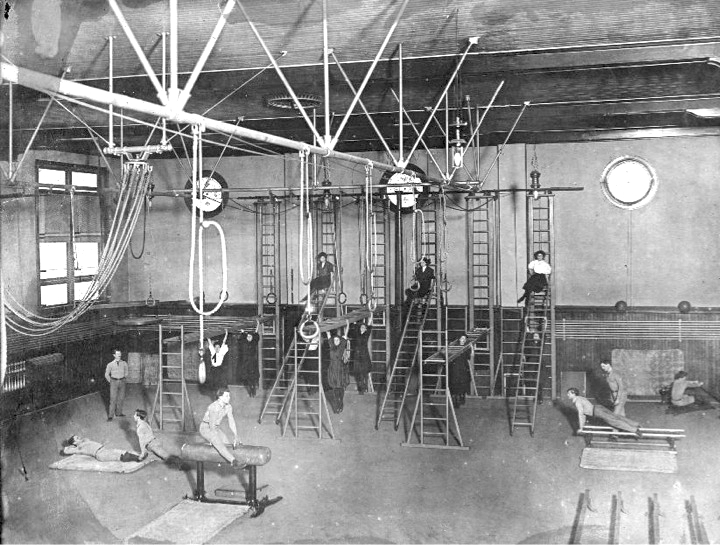“Suspending your body by the arms is a very simple maneuver, yet it is one of the most important therapeutic exercises. Every able-bodied person should do some arm hanging exercises each day, and better yet, do them several times a day.”
–Robert M. Martin, MD, “The Gravity Training System”
Many of you have been following our growing interest in the historical methods of physical fitness and physical education. We’ve been getting good questions about pull up bars and other “off the ground” training. Our ability to use gravity to our advantage in physical fitness and health has a rich history going all the way to Hippocrates. Current examples? A TRX is modified off ground training while the actual pull up bars can be total off the ground training. History teaches us. Let us listen for a few minutes for the lesson of the day…
Ever wonder what old gyms looked like? What kinds of equipment did they have? What exercises were used? Why did they do certain exercises?
Here you go. The above photo was taken during the “Golden Era” of American fitness which was between 1885-1920. The best movers with the best safety existed during this time period. They were far more “physically literate” than we are today. Much of their training was off the ground as you can see below…but why? In the progressions of fitness, we “start” on the ground then move off the ground as a progression. Young children were carefully educated on variety, progression, and precision with both on and off the ground training. Gravity molds our bodies like clay—if you want to change the shape of your body faster—do your homework on the ground so you can get off the ground. What happened after 1920 to decrease our movement quality and continue to decrease our overall fitness as a society? Sports replaced the gymnastic approach. People used to train overall fitness then play sports which creates imbalances then return to the gymnasium for restoratives to fix sport asymmetries. Now? We no longer properly prepare for sports—we just play them. But don’t kids get all this in school PE? Not really as very few wholistic physical education programs currently exist. Real physical “education” also started degrading around 1920.
What’s in the photo? Let’s take a history observation walk moving from left to right.
- On the far left, you will see Indian Clubs neatly racked. These tools were one of the most popular fitness tools in American history, quite restorative, and produced combative benefits as well plus great for brain fitness.
- Note the ropes and rings hanging from the ceiling. Much of the suspension equipment could be retracted out of the way when not in use then cranked down during class. It was very efficient in design from usage to storage.
- You see a man on an exercise mat working abdominal strength. One of the main reasons we have so much back pain today is from weak abdominal postural muscles.
- Moving towards right, you see all kinds of ladder configurations. Vertical, slanted, back ladders, and horizontal ladders. Some gyms had swinging ladders too, but these are not pictured below. All ladder work is off the ground training that requires skill development. How many ladder injuries did people have these days? Not many. Why? They were taught how to climb one!
- WOMEN! Even prior to Title IV, women had a place in American fitness. In fact, previous women were quite strong during this era yet supremely elegant in their movements. The term “Calisthenics” was developed around this time to describe female fitness as “beautiful strength.” Note the women on the horizontals ladders and how they were all totally suspended and hanging full body weight off the ground.
- There is a pommel horse near center. Yes, this is gymnastics. It is important to note that classical physical education programs and physical fitness conditioning were initially focused on the restorative and postural concerns–or a “structure-first approach” which then facilitated greater fitness with higher quality of movement.
- In the upper right corner you will see a man using one of the original rowing machines, so no, Concept2 Rowers were not the first to do it!
- Just below the rower, you will see men using parallel bars and balance beams–both of which are still “off the ground” training even though lower.
- Open floor space. Why? Because they needed to move—not sit.
- NO treadmills, no leg press, no bench press although they did have seated rowing machines as depicted in upper right.
Why does it matter? Because they moved better, safer, and with more elegance. These former Americans had a sophisticated “Physical Literacy.” At The Lean Berets, we take a quality fitness approach and seek to improve physical literacy with EACH training session. The idea from a classical sense is to leave the gymnasium better than when you walked in because you train movement skills. You move safer, cleaner, and continue to develop elegance in your movements. These folks also had a “noble purpose” to their fitness way beyond just toning up and looking good, but more on the noble purpose later…
